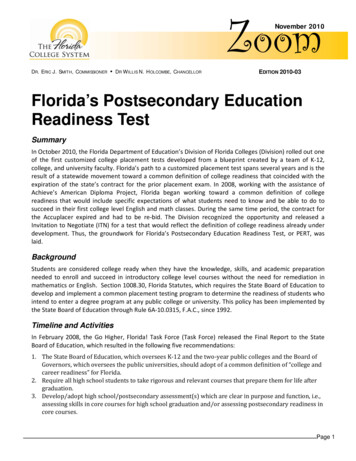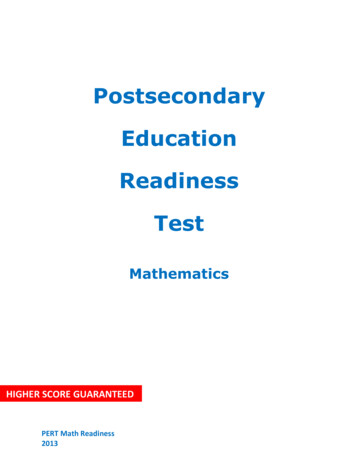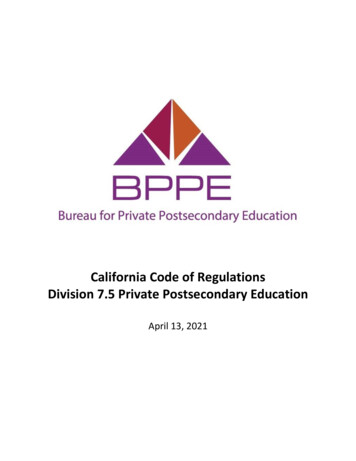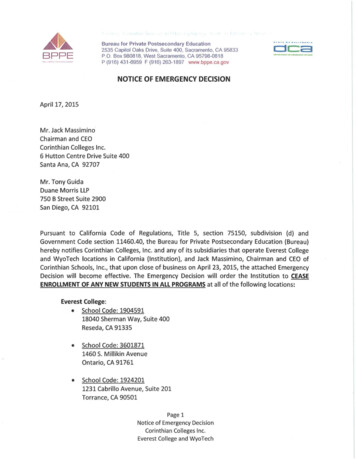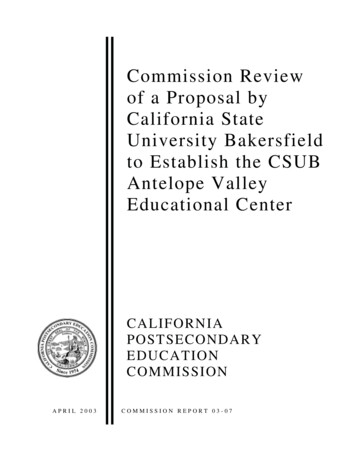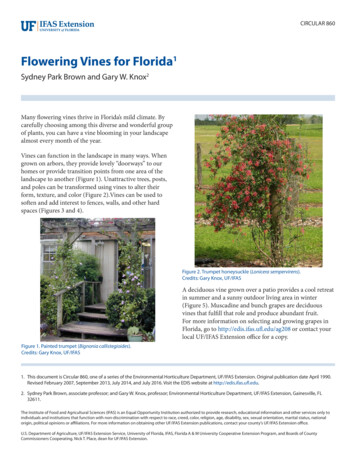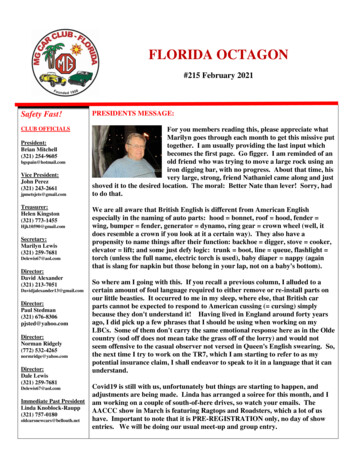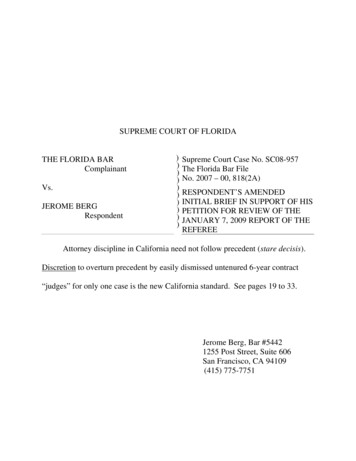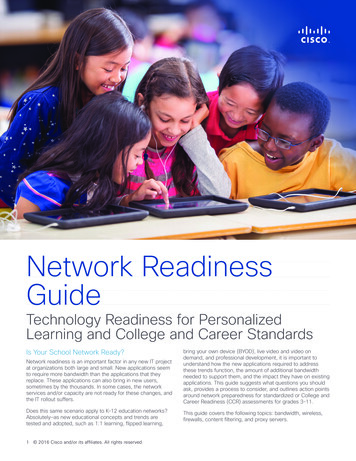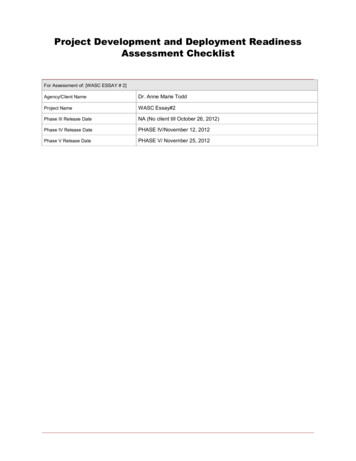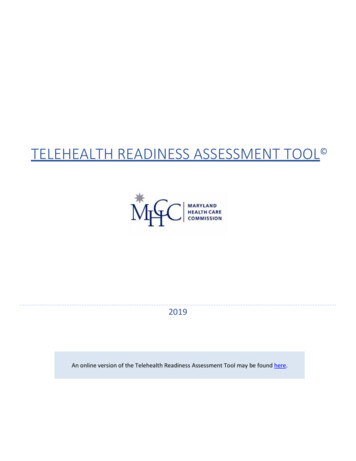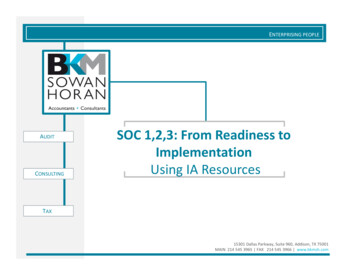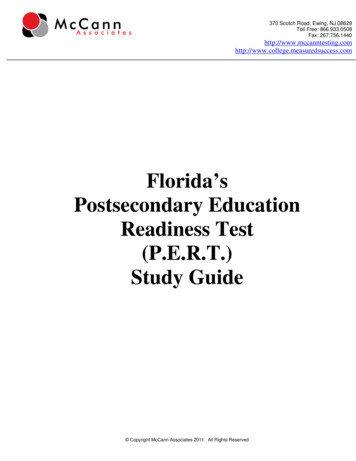
Transcription
370 Scotch Road, Ewing, NJ 08628Toll Free: 866.933.0508Fax: ry EducationReadiness Test(P.E.R.T.)Study Guide Copyright McCann Associates 2011. All Rights Reserved
370 Scotch Road, Ewing, NJ 08628Toll Free: 866.933.0508Fax: .college.measuredsuccess.comIntroductionThe purpose of Florida’s Postsecondary Education Readiness Test (P.E.R.T.) is toadequately assess your academic skills in mathematics, reading and writing through thedelivery of three assessments, one for each of these areas. The results of these assessmentsare used to determine your placement into appropriate courses at your college.You cannot pass or fail the P.E.R.T. – it is only used to determine which courses are bestfor you. While it doesn’t impact your grades, we encourage you to take the P.E.R.T.seriously so that your course placement is accurate.How the P.E.R.T. WorksThe P.E.R.T. assessments are computer-adaptive, which means the questions are chosenbased on your answers to previous questions. You will not be permitted to change youranswer once you have moved on to the next question or leave a question unanswered.However, all of the P.E.R.T. assessments are untimed so you have as much time as youneed to consider each question before submitting your answer. If you do not know theanswer to a specific question, you are encouraged to try and answer the question byeliminating one or more of the answer options and then select from the remaining choices.You will not be allowed to bring a calculator with you; however, for certain questions, apop-up calculator will be available for your use. Check with your college testing center forwhat to bring or not to bring with you on test day.Your scores on each assessment will be available immediately after you submit and yourcollege will provide you with the results.Test Taking Tips PrepareTake practice assessments and study areas of weakness.Read the directions carefullyWhen you take the assessments, make sure to take your time and carefully followthe instructions for each question.Use reasoning when answering1. Identify the key phrase in the question.2. Try to find the correct answer before you read all the choices.3. Eliminate the choices that you know are not correct.4. Read all the choices and pick the best answer.2 Copyright McCann Associates 2011. All Rights Reserved
370 Scotch Road, Ewing, NJ 08628Toll Free: 866.933.0508Fax: .college.measuredsuccess.com ReviewBe sure to review each answer carefully before submitting. You will not be able togo back to any questions.P.E.R.T. Subject Area AssessmentsThere are three P.E.R.T. assessments, each with 30 questions. The content that is tested islisted below by subject:Mathematics: Equations – solving linear equations, linear inequalities, quadratic equations andliteral equations Evaluating algebraic expressions Polynomials – factoring, simplifying, adding, subtracting, multiplying and dividing Dividing by monomials and binomials Applying standard algorithms or concepts Coordinate planes – translating between lines and inspect equations Focusing on pairs of simultaneous linear equations in two variablesReading: Discerning and summarizing the most important ideas, events, or information Supporting or challenging assertions about the text Determining the meaning of words and phrases in context Analyzing the meaning, word choices, tone and organizational structure of the text Determining the author’s purpose and the relation of events in the text to oneanother Recognizing relationships within and between sentences Analyzing the traits, motivations and thoughts of individuals in fiction andnonfiction Analyzing how two or more texts with different styles, points of view or argumentsaddress similar topics or themes Distinguishing between facts and opinions Evaluating reasoning and rhetoric of an argument or explanationWriting: Sustaining focus on a specific topic or argument Establishing a topic or thesis3 Copyright McCann Associates 2011. All Rights Reserved
370 Scotch Road, Ewing, NJ 08628Toll Free: 866.933.0508Fax: .college.measuredsuccess.com Demonstrating use of the conventions of standard written English, includinggrammar, usage and mechanicsSupporting and illustrating arguments and explanationsDeveloping and maintaining a style and toneSynthesizing information from multiple relevant sourcesConveying complex information clearly and coherentlyRepresenting and accurately citing data, conclusions, and opinions of othersEstablishing a substantive claim and acknowledging competing arguments orinformationConceptual and Organizational Skills – recognizing effective transitional deviceswithin the context of a passageWord Choice Skills – recognizing commonly confused or misused words andphrasesSentence Structure Skills – using modifiers correctly; using coordination andsubordination effectively; and recognizing parallel structureGrammar, Spelling, Capitalization and Punctuation Skills - avoiding inappropriateshifts in verb tense and pronouns; maintaining agreement between pronoun andantecedent; and using proper case forms, adjectives and adverbsWhat should you expect?The following section provides an overview of the type of information you will need toknow to perform well on the subject area assessments but it is not intended to be acomprehensive listing of all content to be tested.4 Copyright McCann Associates 2011. All Rights Reserved
370 Scotch Road, Ewing, NJ 08628Toll Free: 866.933.0508Fax: .college.measuredsuccess.comMathematics:You should review your basic math rules such as, the order of operations, exponents, primenumbers and percents. Here are a few of the rules to review:Order of Operations work within parentheses simplify exponents multiplication and division addition and subtractionExponentsThe mathematical notation that notates a variable is multiplied by itself the number oftimes indicated by the exponent. x3 x x x x5 x x x x xPrime NumbersA prime number is defined as an integer that is greater than 1, and has only two positivefactors, 1 and itself. The first ten prime numbers are 2, 3, 5, 7, 11, 13, 17, 19, 23, and 29.PercentsThe word percent means “hundredths” or a number which is divided by 100. Converting anumber into a percentage involves multiplying the number by 100.A percent can be determined by performing the division of the part by the total andmultiplying it by 100:Percent Part 100Total5 Copyright McCann Associates 2011. All Rights Reserved
370 Scotch Road, Ewing, NJ 08628Toll Free: 866.933.0508Fax: .college.measuredsuccess.comMath Sample Questions:1. Which of the following is a solution to the equation c (4 – 3c) – 2 0?A.B.C.D.-10122. Graph the solution of y – 2 1 on a number . Which of the following is a solution to the equation x2 – 6x 5 0?A. x -5B. x -1C. x D. x 54. What is the value of the algebraic expression if x , y -1, and z 2?6x(y2z)A. -12B. -6C.1D.66 Copyright McCann Associates 2011. All Rights Reserved
370 Scotch Road, Ewing, NJ 08628Toll Free: 866.933.0508Fax: .college.measuredsuccess.com7 Copyright McCann Associates 2011. All Rights Reserved
370 Scotch Road, Ewing, NJ 08628Toll Free: 866.933.0508Fax: .college.measuredsuccess.com5. Which of the following is equivalent to (8 – 5) 23 ?A.B.C.D.6. Factor completely:x2 – x – 6?A.B.C.D.(x – 2)(x 3)(x – 1)(x – 6)(x 2)(x – 3)(x 1)(x – 6)7. Simplify the following expression:3x4y22xyA.B.C.D.8. Which of the following is equivalent to the expression (3ab)(-5ab)?A.B.C.D.-2ab-2a2b2-15ab-15a2b28 Copyright McCann Associates 2011. All Rights Reserved
370 Scotch Road, Ewing, NJ 08628Toll Free: 866.933.0508Fax: .college.measuredsuccess.com9 Copyright McCann Associates 2011. All Rights Reserved
370 Scotch Road, Ewing, NJ 08628Toll Free: 866.933.0508Fax: .college.measuredsuccess.com9. What percent of the grid is shaded?A.B.C.D.35%40%45%55%10. Which of the following is the equation of a line that passes through (-2, -1) and (-4, -3)?A. y x 1B. y x 1C. y x–1D. y x – 110 Copyright McCann Associates 2011. All Rights Reserved
370 Scotch Road, Ewing, NJ 08628Toll Free: 866.933.0508Fax: .college.measuredsuccess.comReading:Read each passage carefully. Since the assessment is not timed, take as much time as youneed to read each passage. Each passage may have one or more questions.A helpful strategy is to focus on the opening and ending sentences of each paragraph toidentify the main idea. Another strategy is to look for key words or phrases within thepassage that indicate the author’s purpose or the meaning.Reading Sample Questions:Read the selection and answer the questions that follow.A Born ArtistBenjamin West was born in a small town near Philadelphia, Pennsylvania, in 1738.Soon after Benjamin's birth, the family minister paid a visit. "This boy will do greatthings someday," the minister said. The minister's words left the Wests wondering whatmight be in store for their son. Then, when Benjamin was seven years old, he drew apicture of his baby niece. Benjamin's parents were stunned to see how skilled hisdrawing was. Perhaps it is a sign, they thought.As he grew up, Benjamin drew whenever he could. He especially liked drawinganimals he saw in the fields and woods near his house. One day, as Benjamin wasdrawing a robin, three Lenape Indians passed by. They looked at the drawing and, intheir own language, discussed what was wrong with it. Finally, one of the Lenape toldBenjamin in English that the robin's breast should be red. When Benjamin explainedthat he didn't have any paint, the Lenapes dug some red and yellow clay from theriverbank and showed him how to make paint from the clay.Benjamin ran home with his red and yellow paints. When his mother saw howexcited he was, she gave him some blue indigo, which she used to dye wool. NowBenjamin had the three primary colors, which he could mix to make other paint colors.But Benjamin still needed a brush. There was no place around to buy one, so Benjamindecided to make his own. When his parents weren't looking, he snipped some hair fromhis cat's tail. Then he pressed the hairs to the tip of a goose quill and wound yarnaround the tip to secure the hairs.The brush worked, but not for long. After it fell apart, Benjamin made more. SoonMr. and Mrs. West saw that the family cat was missing great patches of fur. At firstthey were furious, but then they softened. They knew that a boy who would go to suchlengths to paint must be special. So they bought Benjamin paints, brushes, and somecanvas.11 Copyright McCann Associates 2011. All Rights Reserved
370 Scotch Road, Ewing, NJ 08628Toll Free: 866.933.0508Fax: .college.measuredsuccess.comFrom these beginnings, Benjamin West became a great and famous painter. In 1763he moved to England and never returned to America. Although he taught himself topaint, he was happy to teach younger artists, especially ones who traveled from theUnited States to study with him. For this reason, West is often called the father ofAmerican art.1. Which of the following statements is the best summary of this selection?A. Benjamin West drew pictures of his niece and a robin. Then, he became interestedin painting instead.B. As a young child, Benjamin West loved to draw and paint. He grew up to become agreat and famous painter.C. Benjamin West taught himself to draw. Then some Indian friends and his parentsgave him painting supplies.D. A minister predicted that Benjamin West would do great things someday. Hisparents soon discovered that Benjamin was special.2. How is the information in this selection organized?A.B.C.D.In chronological orderAs a list of problems and solutionsIn a series of questions and answersFrom least important to most important3. As it is used in this selection, the word secure means —A.B.C.D.free from danger.to take or get.sure or certain.to fasten or hold tight.4. The author’s main purpose in writing this selection was to —A.B.C.D.persuade young artists to keep drawing.show that art supplies can be made from everyday things.entertain with a story about a young artist.inform readers about art long ago.12 Copyright McCann Associates 2011. All Rights Reserved
370 Scotch Road, Ewing, NJ 08628Toll Free: 866.933.0508Fax: .college.measuredsuccess.comRead the selection and answer the questions that follow.King of the SeaThor Heyerdahl, a famous adventurer from Norway, could not swim. He nearlydrowned more than once when he was a teenager. For a long time he was afraid ofwater. It's surprising, then, to learn that he spent much of his life sailing delicate boatson the world's oceans.In 1947, Heyerdahl set off on his first great adventure. He hoped to cross the PacificOcean from South America to Polynesia. Heyerdahl thought that early people mighthave migrated to Polynesia thousands of years ago by sea. He reasoned that if he couldfollow this route in a simple raft, he would show it was possible.Heyerdahl constructed a raft of balsa wood and set out to cross the Pacific Ocean.This wood is so light that today it is used for model airplanes. Critics thought the raftwould get waterlogged and sink, but they were wrong. The raft, called the Kon-Tiki,landed in Polynesia afte
Reading Sample Questions: Read the selection and answer the questions that follow. A Born Artist Benjamin West was born in a small town near Philadelphia, Pennsylvania, in 1738. Soon after Benjamin's birth, the family minister paid a visit. "This boy will do great things someday," the minister said. The minister's words left the Wests wondering .
